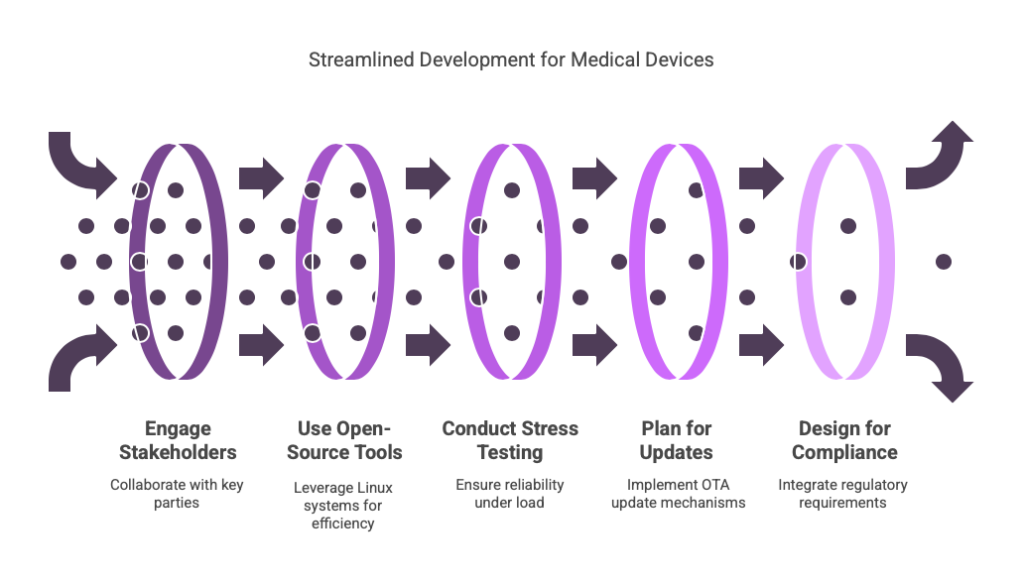Introduction
Custom Linux board development is a cornerstone of high-performance embedded systems, providing developers with the flexibility and power needed to design cutting-edge solutions. In the medical and wellness industries, these boards power devices ranging from advanced diagnostic tools to wearable health monitors. This article dives into the nuances of custom Linux board development, offering actionable tips, highlighting pros and cons, and providing practical insights for developers in this specialized field.
Table of Contents
What is Custom Linux Board Development?
Custom Linux board development involves designing and configuring hardware platforms that run Linux, tailored to specific application requirements. This process includes selecting components, developing hardware drivers, optimizing the Linux kernel, and creating user-space software to meet performance, reliability, and scalability goals.
Why Custom Linux Board Development Matters for High-Performance Systems
Optimized Performance
Custom boards enable developers to fine-tune hardware and software interactions for maximum efficiency and responsiveness, crucial for applications like real-time patient monitoring.
Tailored Functionality
A custom Linux board ensures that every component and feature is specifically designed to meet the unique requirements of the target application, avoiding unnecessary complexity.
Open-Source Flexibility
Leveraging Linux’s open-source nature allows developers to modify and optimize the operating system, ensuring compatibility and performance without the constraints of proprietary solutions.
Scalability
Custom boards provide a scalable foundation, enabling systems to handle growing data, user demands, or feature expansions seamlessly.
Applications of Custom Linux Boards in Medical and Wellness Devices
Diagnostic Imaging Systems
- Process large datasets from imaging sensors (e.g., MRI and CT scanners) with minimal latency.
- Enable real-time visualization and AI-powered diagnostics.
- Integrate with hospital networks for secure data sharing.
Wearable Health Monitors
- Support low-power operation for extended battery life.
- Provide seamless connectivity with smartphones and cloud platforms.
- Process real-time health metrics like heart rate, blood oxygen, and activity levels.
Robotic Surgical Systems
- Deliver precise control of robotic movements and tools.
- Integrate imaging and monitoring data in real time.
- Ensure reliable and low-latency performance during critical procedures.
Portable Diagnostic Devices
- Power compact devices for use in remote healthcare settings.
- Optimize for durability and energy efficiency.
- Enable secure IoT connectivity for remote diagnostics and updates.
Tips and Tricks for Custom Linux Board Development
1. Select the Right Hardware
- Choose processors that match the computational needs of your application, such as ARM-based chips for low-power devices or x86 processors for high-performance systems.
- Include hardware acceleration for tasks like encryption, AI inference, or image processing if applicable.
2. Optimize the Linux Kernel
- Remove unnecessary kernel modules to reduce overhead and improve boot times.
- Use real-time patches like PREEMPT-RT for time-sensitive applications.
- Customize drivers to ensure seamless integration with hardware components.
3. Prioritize Power Efficiency
- Implement dynamic voltage and frequency scaling (DVFS) to optimize power usage.
- Enable sleep modes for unused components during idle periods.
- Profile power consumption during development using tools like PowerTOP.
4. Secure the System
- Implement secure boot to ensure only trusted firmware and operating systems run on the board.
- Use SELinux or AppArmor for mandatory access control policies.
- Encrypt sensitive data at rest and during transmission.
5. Optimize for Connectivity
- Use lightweight communication protocols like MQTT for IoT applications.
- Implement redundant connectivity options (e.g., Wi-Fi and cellular) for critical medical devices.
- Test connectivity in real-world environments to ensure reliability.
6. Debug Efficiently
- Use tools like JTAG for low-level hardware debugging.
- Leverage Linux debugging tools such as GDB, strace, and dmesg for software issues.
- Create robust logging mechanisms to identify and address issues quickly.
Pros and Cons of Custom Linux Board Development
Pros
- Tailored Solutions: Custom boards meet specific application needs without unnecessary features.
- Cost Control: By using open-source Linux, developers eliminate licensing fees and avoid dependency on proprietary platforms.
- Performance Optimization: Fine-tuning hardware and software interactions ensures high efficiency.
- Security Features: Customization allows for robust security implementations.
- Scalability: The ability to adapt systems for future requirements makes custom boards ideal for long-term projects.
Cons
- Development Complexity: Designing and configuring custom boards requires significant expertise and time.
- Higher Initial Costs: Upfront investment in design and development is higher compared to off-the-shelf solutions.
- Maintenance Demands: Custom boards require ongoing updates and support, including kernel patches and hardware driver maintenance.
- Compatibility Challenges: Ensuring compatibility with third-party components or systems can be difficult.
Practical Insights for Developers
- Engage Early with Stakeholders: Collaborate with end-users, regulatory bodies, and hardware manufacturers early in the design process to align on requirements and compliance.
- Leverage Open-Source Tools: Use Linux build systems like Yocto or Buildroot to streamline development and ensure reproducibility.
- Conduct Stress Testing: Test the board under peak loads to identify bottlenecks and ensure reliability.
- Plan for Updates: Implement mechanisms for over-the-air (OTA) updates to ensure the system can adapt to future requirements.
- Design for Compliance: Build security and safety features into the system architecture to meet medical industry regulations like FDA and ISO standards.

Future Trends in Custom Linux Board Development
AI Integration
Custom boards will increasingly support AI-powered features, enabling advanced analytics and real-time decision-making in medical devices.
Edge Computing
Custom Linux boards will play a pivotal role in edge computing, allowing medical devices to process data locally and reduce latency.
Sustainability
Future development will emphasize energy-efficient designs and eco-friendly manufacturing practices, aligning with global sustainability goals.
5G Connectivity
The integration of 5G will enable ultra-reliable low-latency communication for next-generation healthcare devices.
Advanced Security
Custom Linux boards will adopt cutting-edge security features, including blockchain for secure data handling and decentralized verification.
Conclusion
Custom Linux board development is a transformative approach to building high-performance systems in the medical and wellness industries. By enabling optimized performance, tailored functionality, and robust security, these boards empower developers to create innovative and reliable solutions. By following the tips and insights outlined here, developers can navigate the complexities of custom Linux board design and deliver scalable, future-proof systems that enhance patient care and operational efficiency.
For more insights into medical device innovation, explore our Optical Medical Device Commercialization Guide.



